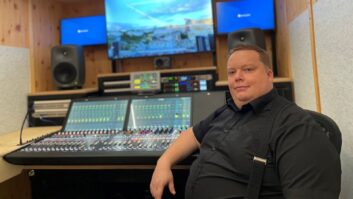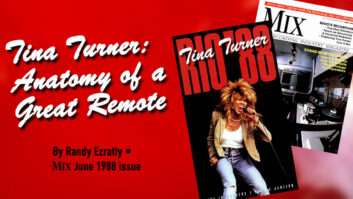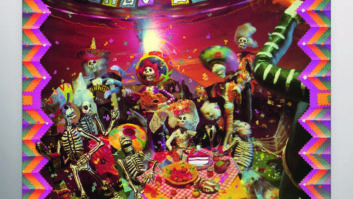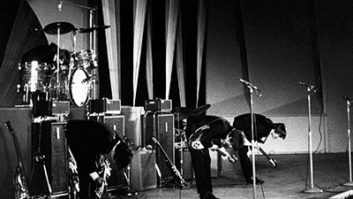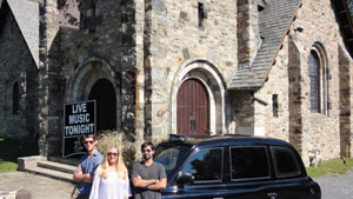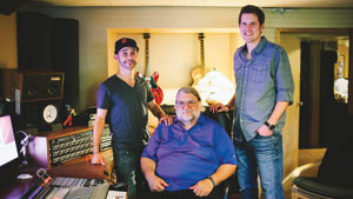
The shift in record-making toward high-end project rooms has forced many commercial facilities to rethink their marketing strategies and come up with new ways of attracting clientele. A similar shift is happening in live recording, once the province of dedicated remote vehicles. Recording a band in a live situation is often a quick and relatively inexpensive way for a label to release a new product and provides an opportunity for material to be repurposed for video and/or multichannel audio release. And while there will always be a place for the big trucks on the big shows, the rise of portable rigs has opened up professional-quality recording to bands on a D.I.Y. budget.
Philip Harvey in the Hammerstein Ballroom
Philip Harvey, front-of-house engineer for Medeski, Martin & Wood, The Mavericks and Ozomatli, became interested in live recording “when laptops started getting powerful. I never bought ADAT or DA-88 decks because of the bulk of transporting four units for multitracking,” says Harvey. “I thought it would be amazing if I could carry a four-space rack and a PowerBook to ultimately have the ability to do 24/96 recordings. Initially, I was looking for a high-quality FireWire interface for my laptop to use with Metric Halo’s SpectraFoo audio analysis software, and when they began developing their proprietary record panel software, I started using the Mobile I/O 2882 to make 8-channel recordings of MMW’s shows. Upon developing a closer relationship with Metric Halo, they decided to let me take three additional 2882+DSPs into the field as a beta tester.
“To start with, I used a 400MHz graphite PowerBook G3,” he continues. “Because the two FireWire ports on that machine share a common bus, I separated the streaming audio from the audio writing to disk onto two different buses so I could record 32 channels of audio at 24-bit/48 kHz. I plugged the Metric Halo units into a PCMCIA FireWire adapter card and plugged the audio drive into the G3’s FireWire port. The 2882+DSP has an onboard chipset that handles audio processing — including MIOstrip, EQ, limiter and M/S encoding/decoding plug-ins — leaving the laptop to handle the GUI and writing to disk. To me, that’s the magic bullet. A lot of other FireWire audio interfaces leave the processing to the computer, slowing things down. I was amazed that by using a 400MHz laptop, I could get 32 channels of audio.”

The Tourmystudio crew, from left: Stuart Holverson, Chris Shepard and Steve Weeder
Chris Shepard, music studio manager at Chicago Recording Company, and engineers Steve Weeder and Stuart Holverson are responsible for the operations of Tourmystudio (www.tourmystudio.com), a portable recording rig that Shepard assembled “out of necessity. I was doing more ‘remote-style’ projects where I’d be pulling together a recording system from gear I had on hand plus interfacing rental gear. It’s a waste of resources. I’d rather have everything connected and ready to go. I wanted a rig I could become familiar with that would be reliable and quick to set up. In the past, when assembling a mobile rig, I’d always be building a bastard cable to make something work — usually the headphone system! My goal was to have the gear internally prewired and cased so all I’d have to do was connect the cases and add power.”
Shepard’s rig comprises a Pro Tools|HD3 system (one Core and two Process cards) running on a G4/dual 1.25 GHz with 48 True Systems mic preamps for the front end. The “analog” audio rack contains six True Systems Precision 8 8-channel mic pre’s, a Furman HDS-16 headphone distribution system and Tripp Lite power backup. A second shock-mounted “digital” rack houses the G4, a Digidesign Sync I/O clock generator, three Digi 192 I/O audio interfaces, a MIDI I/O and an HHB CDR850 Plus CD recorder. The rear panel of the analog rack has a 48-pair connector made by Rapco, allowing a stage snake to connect to the input of the preamps via one connector.
“Since the analog inputs to the Digidesign 192s are on DB25 connectors and the outputs of the True preamps are also on DB25 connectors, I installed DB25 patch panels on the rear of each rack,” Shepard explains. “This avoids plugging directly into the back of the True preamps or the Digi 192s and wearing down or damaging those connectors. The DB25 connectors on the rear panels of the racks can easily be replaced if necessary. It’s a very idiot-proof system that can be easily connected under low-light conditions — typical for us since we’re often on the side of the stage. There is one power cable coming out of each rack, and the Tripp Lite UPS gives me 10 minutes of backup time if there is an incident, like if the show is over and someone pulls the AC while we are backing up data from hard disk.”
In addition to two Mackie SDR24/96 24-track recorders, Scott “Squat” Levy of HyperSonic Audio in Santa Fe, N.M., uses an HHB PDR2000 24-bit/96kHz portable hard disk recorder with a pair of AKG C1000s for “pre-production” recording. “My forte is working with emerging artists, though I do a fair amount of work with established artists, too,” begins Levy. “I try to sell my production abilities, help the band focus on their goals for recording and prepare them to meet those goals. I don’t just show up at a venue and do a recording, because chances are slim that they’ll be able to use it for commercial purposes. We address everything ahead of time — from picking the right songs for the performance to changing the strings on their guitars, putting new heads on the drums and making sure that their amps don’t make any weird noises. Those are very simple things that young bands often overlook. I’ll attend a rehearsal and show beforehand, record using the PDR2000 and make CDs of the show. Then we’ll meet to listen through them and see what needs improvement.”
NOWHERE TO HIDEBAll three engineers agree that isolation can be a problem in live recording situations where a remote truck is not being used. When possible, Shepard sets up in an isolated space at a venue. “At the Metro [Chicago], we set up on a different floor and monitor on a pair of Genelec 1031s,” he says. “That’s a lot of fun because nothing is better than ‘hot mixing’ a live show in that spooky old theater. But there are times when we don’t have that isolation and it’s difficult to hear. A few months ago, we recorded KMFDM at the House of Blues in Chicago and had to set up next to front of house to facilitate the split. In a situation like that, we record the soundcheck. By the time the band hits the stage, I’ve had an hour or two to play with the mix, so my EQs and compressors are somewhat set and I don’t have very far to go once the show starts. Nothing beats being on the side of the stage near the monitor engineer’s position. You can look up and watch the vocalists stepping up to the microphones and you can anticipate the mix, which is difficult to judge from the front. Plus, communication with the monitor engineer is quick and easy in the event of a problem.”
With Medeski, Martin & Wood, Harvey had to record at front of house because he was also performing live mixing duties. “We carried a Midas Heritage 3000 running 33 channels total and I submixed a couple of those to subgroup outs,” he recalls. “The channel direct outs of the Midas can be set pre-EQ and pre-fader, so I was using the mic preamps of the Midas console and patching those to the 2882s, which handled A/D at 24/44.1. I didn’t record with processing; I just tried to capture the naked sound to be processed in the Pro Tools mixes later. After the gig was over, I’d import the tracks into a Pro Tools session. The Metric Halo software records files in SDII format, so they open directly into a Pro Tools session. Then I’d use an Mbox for putting together rough mixes on the road so the band could hear what we captured. None of those shows have been released, though we did a show for XM Radio.”
For an upcoming tour in France with Patricia Barber, Harvey will be recording eight shows using the Metric Halo software at 24-bit/96k resolution for her next release. “I’m carrying a 17-inch, 1GHz PowerBook with 1GB RAM, three Metric Halo 2882+DSPs in one rack and a second rack with one 2882+DSP and a Metric Halo ULN-2+DSP. I want to integrate the ULN-2 because the preamps sound phenomenal and will be perfect for Patricia’s vocals. We’re renting a three-way split in France, and wherever possible, I’ll try to be in a separate room monitoring on headphones. Most of the recording microphones will be the same as the ones for the P.A., and I’ll take the signal from the split into the mic preamps of the 2882+DSPs. There are 18 channels total, giving me room for a few extra recording mics, so I’ll probably add a pair of Schoeps MK4s for the piano and another pair for the room sound. The interfaces each have four XLR and four TRS jacks with preamps on each input that are configurable for +4, -10, line, mic [with 48V phantom power] or instrument level. We’ll get a rehearsal to work on levels, and once we do the first show, we should pretty well be set. After the tour is over, I’ll hand off the drives to their engineer for mixing.”
Although Levy also prefers to set up in a spare room in the venue and monitor through a pair of Mackie HR824s, being near the front-of-house engineer allows him to hone in on his reference 2-track mix. “In addition to the close mics, which are recorded to independent tracks, I like to put up at least two pairs of room mics: one near and one distant,” he reveals. “Those mics are the foundation for my 2-track live mix to an Alesis MasterLink ML-9600. When I record stage shows with dancing or performance art, I tend to use the room mics heavily, especially if people are moving around. In certain situations, AKG SolidTubes make good room mics because they have a broad pattern and a warm sound.” During soundcheck, Levy will mute the 2-track mix’s close mics and attempt to match the mics’ sound to what he is hearing in the room. While he depends on room mics during dancing or performance art shows, Levy opts for a close mic for orchestral or acoustic performances, placing it on a cello or bass, for example, for more definition. However, he does note that higher-register instruments are easily picked up by carefully placed room mics. The sound that is picked up from the close mics are shuttled to a completely independent mix to the 2-track via a Mackie 32•8, which Levy will also employ for added mic pre’s or to sum multiple mics to a bus. “One of the cool things about doing the 2-track is that if the band is on a break, we can listen to the CD in the green room. If there’s a critical song they didn’t do well in the first set, we can get another take in the next set.”
In addition to the Mackie SDR24/96s, Levy carries 24 channels of Focusrite Platinum OctoPre mic preamps and feeds 24-bit/96k audio to the Mackie SDRs via Lightpipe. “If I use the A/Ds on the Mackie SDR24/96, I can only record 12 tracks at 24/96,” he explains. “Since the Focusrite preamps are doing the conversion, I can route digital output from the preamps to digital inputs of the SDR and record 24 tracks simultaneously. I also have the option of using the analog outs on the Focusrites and patching into a processor before going either to the Mackie SDR or to the Mackie console. I prefer to either change the mic or move it to get the sound I’m after, as opposed to processing.” To do this, Levy brings a wealth of outboard gear that comprises a PreSonus ACP-88 and a smattering of Ashly Protea 2.24PS stereo, digital, 12-band parametric EQs. He rarely employs gates or compression, but likes to know that they are there if needed. Levy will also bring out the Ashly EQs when he needs to use the same mic on a multi-instrumentalist. Because the Ashly EQs offer 24-bit digital output, Levy can remain in the digital domain.
“The keys to success in any live recording are preparation in setup and microphone selection and placement,” Levy elaborates. “The mics have to be multipurpose, suited for live performance and have superior sound-capture quality. Microphone placement is critical to maximize rejection, avoid distortion, capture subtle over- and undertones, and not cause problems with feedback in the front-of-house or monitor mixes.”
CUE COMMUNICATION
For Shepard, one of the most challenging aspects of using a portable recording rig has been setting up a cue system. “Talkback and headphones were always a problem, and by solving those issues, we make artists happy fast,” he says. “Our solution is a multichannel cue mix system produced by Furman. It consists of an HDS-16 headphone distribution system and HRM-16 remote mixers. The HDS-16 has a patchbay on its front panel that interfaces with Pro Tools. We create a series of pre-fader aux sends in the Pro Tools session and route each aux to an analog output on the 192s. The outputs from the 192s are then patched into the eight mono and four stereo inputs of the HDS-16. Usually, I start with individual channels for kick, snare, bass, guitar, vocal, et cetera, and use the stereo channels for the drum kit, keys and percussion. The HDS-16 distributes these signals and power to the HRM-16 mix stations via 50-pin Centronics cables. Each musician gets a remote station so they can have their own headphone mix. I’ll set up a rough mix, show the artist the labeled inputs and let each musician tweak from there. The only time their levels change is when I change the level at the mic preamp, but that would be true of any console. Each mixer has a built-in talkback microphone with a switch, so I don’t have to set up separate mics for communication. The HDS-16 has an internal talkback bus I/O so anytime someone presses their talkback switch, everyone can hear them in the headphones and I can hear them via the talkback input on my ProControl.”
In spite of the move toward high-resolution audio formats, most of Shepard’s recordings run at 44.1 kHz. “Most clients request 44.1 or 48 kHz,” he says. “People haven’t been asking for the higher sample rates and that’s fine. We have to be careful that we don’t lock a client into a format that they cannot take back to their own studio and continue working on. The other day we did our first session at 192 kHz: a pipe organ at a church in Rockford, Illinois. In a situation like that, it might be more appropriate to use a higher sample rate, but for live recordings, we’ve found that 44.1 and 48 kHz do the trick.”
Although he prefers to produce the entire project, Levy is comfortable with the idea of capturing the performance, handing it off to the band and directing them “to a capable studio. One of the interesting things is that, if I came to Santa Fe and opened a new studio, local studios would not be too happy,” Levy says. “But when I do a live recording and feed it to them, they get work that would not otherwise come their way. I might recommend the band to a place like Pachyderm [Cannon Falls, Minn.], Tone Zone or Rax Trax in Chicago, Step Bridge in Santa Fe or Santa Fe Center Studios in Albuquerque. They know I am not sending them garbage, and I know they are capable of finishing the project in a professional manner. From the band’s point of view, they can spend $10,000 on a tracking session at a studio and get maybe 12 songs. I can do two nights, two sets each, for under $2,000, and they can get as much as two records’ worth of material. If they spend another $5,000 mixing, they are still under the $10,000 they’d spend on a studio recording, and it’s a better product because they are turning in a good performance.”
In addition to contributing to Mix, Steve La Cerra is a freelance engineer and producer based in the New York City area.
